Lego architecture 21051 токио
Обновлено: 02.05.2024
Требуются инструкции по сборке из вашего набора ЛЕГО set 21051 Architecture Токио? Ниже вы можете просмотреть и загрузить бесплатно инструкции по сборке в формате PDF. Кроме того, приведены часто задаваемые вопросы, рейтинг изделия и отзывы пользователей, что позволит оптимально использовать ваше изделие. Если это не то руководство, которое вы искали, – свяжитесь с нами.
Ваше устройство неисправно, и в руководстве отсутствует решение? Перейдите в Repair Café для получения бесплатных ремонтных услуг.
Руководство
Рейтинг
Сообщите нам, что вы думаете о ЛЕГО set 21051 Architecture Токио, оставив оценку продукта. Хотите поделиться вашими впечатлениями от данного изделия или задать вопрос? Вы можете оставить комментарий в нижней части страницы.
Часто задаваемые вопросы
Наша служба поддержки выполняет поиск полезной информации по изделиям и отвечает на часто задаваемые вопросы. Если вы заметили неточность в наших часто задаваемых вопросах, сообщите нам об этом с помощью нашей контактной формы.
В наборе нет одного элемента Lego, где можно заказать запасной? Проверенный В компании Lego работает служба, где можно заказать отдельные элементы или куда можно обратиться в случае нехватки элементов в наборе. Дополнительную информацию см. на веб-сайте.
Это было полезно ( 3631 ) поделиться
Как предотвратить изменение цвета игрушек Lego? Проверенный Цвет пластиковых игрушек Lego меняется по двум главным причинам: длительное воздействие солнечного света или сигаретного дыма. Постарайтесь минимизировать воздействие этих факторов на ваши игрушки Playmobil.
Это было полезно ( 1227 ) поделиться
Как лучше всего чистить детали конструктора Lego? Проверенный Lego советуют чистить детали вручную с помощью воды (не выше 40°C) и щадящего чистящего средства. Никогда не мойте детали Lego в посудомоечной или стиральной машине. Оставьте детали сушиться на воздухе. Очищайте электрические детали исключительно сухой тканью.
Это было полезно ( 1111 ) поделиться
Каждый раз после сборки нового набора Lego у меня остается несколько маленьких деталей. Я забыл(-а) ими воспользоваться? Проверенный Нет, во многих наборах Lego есть запасные детали для мелких элементов.
Это было полезно ( 880 ) поделиться
Как лучше всего наносить наклейки на детали Lego? Проверенный Чтобы наклейки можно было переклеить, рекомендуется обработать место нанесения наклейки средством для очистки стекол. После размещения наклейки дайте ей высохнуть, чтобы она держалась на месте.
Это было полезно ( 783 ) поделиться
Можно ли использовать детали Lego и Duplo вместе? Проверенный Да, детали Lego и Duplo совместимы. Детали Lego устанавливаются на детали Duplo с полыми шипами. Детали Duplo лучше всего устанавливаются на более крупные детали Lego, на мелких деталях они могут держаться хуже.
Это было полезно ( 706 ) поделиться
С какого возраста можно играть с Lego? Проверенный Большинство наборов Lego предназначены для детей от 4 лет, поскольку содержат мелкие детали. Специальная серия Duplo предназначена для детей от 1,5 лет. Возрастные ограничения всегда указываются на коробке.
Это было полезно ( 683 ) поделиться
Где я могу найти список деталей моего набора Lego? Проверенный Многие современные инструкции Lego включают список деталей в конце буклета. В случае нескольких буклетов список можно найти в середине PDF-файла.
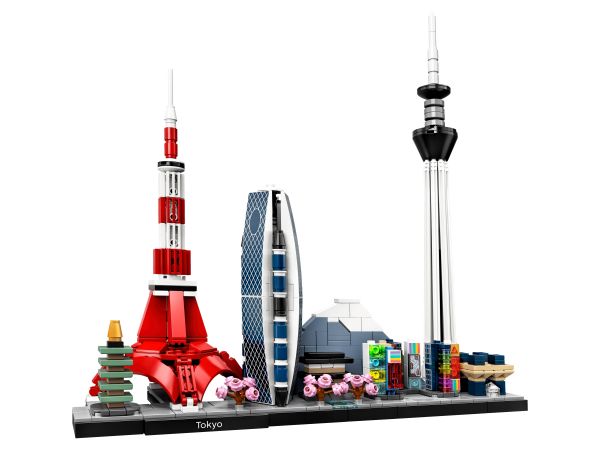
Токио - столица Японии, её центр во всех сферах деятельности. И, как любой столице, ей есть, чем удивить своих гостей.
Tokyo Skytree (Небесное дерево Токио) - является самой высокой телебашней в мире и вторым в мире зданием по высоте (его обгоняет только дубайский Бурдж Халифа высотой 828 м) - его высота 634 м. На телебашне есть две смотровые площадки: на высоте 350 м вместимостью 2000 человек, и на высоте 450 м - вместимостью 900 человек.
В 1958 году была построена теле-радио-башня Токио высотой 332,6 м. На момен т постройки телебашни, она была самой высокой конструкцией из стали. Башня выкрашена в оранжевый и белый цвет. Своей конструкцией она чем-то напоминает Эйфелеву башню в Париже. Как и её французская «сестра», телевизионная башня Токио в культуре используется для указания на то, что действие происходит в Токио. Эту башню Вы можете видеть во многих аниме (японской анимации) и манге (японских комиксах).
Mode Gakuen Cocoon Tower - небоскрёб высотой 204 метра. В этом здании расположены 3 учебных заведения: профессионально-техническое училище моды, колледж технологий и дизайна, а также медицинский колледж.
Токийский экспоцентр «Tokyo Big Sight» - это огромный комплекс, который состоит из двух выставочных центров, конференц-зоны и зоны с кафе и ресторанами.
Наряду с небоскрёбами, токийской достопримечательностью является Сибуйский диагональный пешеходный переход. На этом перекрёстке одновременно дорогу могут переходить до 3000 человек. Это перекрёсток Вы можете наблюдать во многих художественных фильмах. Телевизионные экраны, а также огромные рекламные щиты делают этот перекрёсток ярким и запоминающимся.
Парк Чидоригафучи - является не совсем парком. Точнее, это ров, усаженный сакурой, окружающий Императорский Дворец. Именно во время цветения сакуры этот парк наводняется огромным количеством людей, любующихся этим зрелищем.
Набор Lego 21051 Architecture Токио станет прекрасным украшением Вашей полки или рабочего стола. Это будет чудесное напоминание о проведённом отпуске в столице Японии, или станет чудесной визуализацией Вашей мечты. В собранном виде набор достигает 27 см в длину и 28 см в высоту.
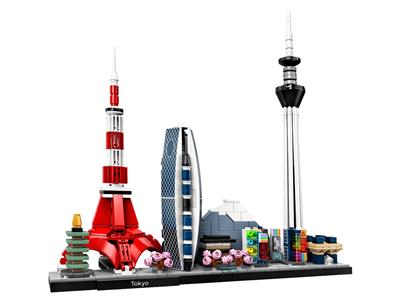
21051 Tokyo is a 547 piece Architecture set released in 2020. The set features models of the Tokyo Tower, Mode Gakuen Coco.on Tower, Tokyo Big Sight, Tokyo Skytree, Chidorigafuchi Park and Shibuya Crossing.
The set is estimated to retire sometime within mid to late 2022. Once retired, the initial annual growth for the first year will be around 22% but will level off closer to 18% after the second year, which will value the set between 100,00 € and 136,00 € shortly after retirement. Based on the annual growth expectations Tokyo is expected to become a valuable collector set.
Retirement risk . Tokyo has a current lifespan of 29 months, based on the average lifespan of other sets in this theme which is 26 months, this set is at risk for retiring in the coming months.
- All regions 73
- United States 51
- European Union 8
- Canada 2
- Australia 3
- Germany 9
For Sale (New/Sealed)
Sets in Architecture / Skylines
21057 Singapore
21052 Dubai
21044 Paris
21028 New York City
21039 Shanghai
21043 San Francisco
21047 Las Vegas
21038 Las Vegas
21034 London
21033 Chicago
21032 Sydney
21027 Berlin
21026 Venice
My Collection
Set Details
Set Pricing Expected Very Good Investment
Quick Buy
Set Predictions
Set Facts
- Tokyo Tower - the second highest tower in Japan and a major tourist attraction.
- Mode Gakuen Cocoon Tower - education tower with three universities inside and the second tallest educational institute in the world.
- Chidorigafuchi National Cemetery - a Japanese war cemetery for unidentified soldiers.
- Shibuya Crossing - a crossing in the Shibuya district that is analogous to Times Square.
- Tokyo Skytree - the tallest structure in Japan and the second tallest structure in the world.
- Tokyo Big Sight - a convention center in Tokyo that is the largest convention center in Japan.
- Tokyo was designed by LEGO designer Rok Zgalin Kobe.
Tokyo Reviews
“ Much like the real city, 21051 Tokyo manages to pack an awful lot into a relatively small space and although there's a diverse mix of colours and building styles, nothing clashes. Each year the Skyline theme pushes the boundaries and 21051 Tokyo, as the first of 2020, may . More just be one of the best yet.”
“ The model offers a number of useful new parts and an enjoyable construction process full of techniques and details to keep the interest of the builder. The addition of a brick-built Mount Fuji is particularly appreciated, offering a backdrop for the shorter sections of the . More model, and helping the finished model to stand out when compared to previous Skylines sets which have lacked natural landmarks.”
Subtheme Analysis
About Architecture Skylines
The LEGO Architecture Skylines series highlights a number of famous structures within a city skyline and explores several landmarks from a single city, rather than focusing on just one building such as the Landmark Series. The series was introduced in 2016 and now contains more than a dozen sets representing cities such as New York City, Venice, Sydney, Chicago, London, Paris and many more.
Skylines was introduced in 2016 and currently consists of 14 sets. As of today, 21038 Las Vegas is the most valuable Skylines set with an estimated new/factory sealed value of 893,00 €.
Recreate some of Tokyo’s most famous buildings with this detailed LEGO® Architecture Skyline Collection 21051 desk toy. It’s a great souvenir for Tokyo visitors and an ideal gift for adults who live or have lived in Japan’s capital city or who dream of visiting. Even LEGO newcomers can zone out from busy lives and enjoy this relaxing building experience.
Iconic buildings This toy construction set includes scale models of TOKYO SKYTREE, the world's tallest freestanding tower, Tokyo Tower, Mode Gakuen Cocoon Tower and Tokyo Big Sight. The cherry-tree-filled Chidorigafuchi Park, a classic pagoda tower and Shibuya Crossing are also featured. Together on the baseplate with a ‘Tokyo’ nameplate, they create a compact, impactful display piece.
Introducing LEGO Architecture… LEGO Architecture sets capture the essence of the world's best-known buildings, monuments and cities. From iconic landmarks to city skyline models, there's something for anyone interested in architecture.

Change region and currency
We hope you all had a good Christmas and got some brick-based treats from Santa. Looking forward to 2020? Ben Davies is here to get you in the mood with a beautiful new Architecture set: 21051 Tokyo.
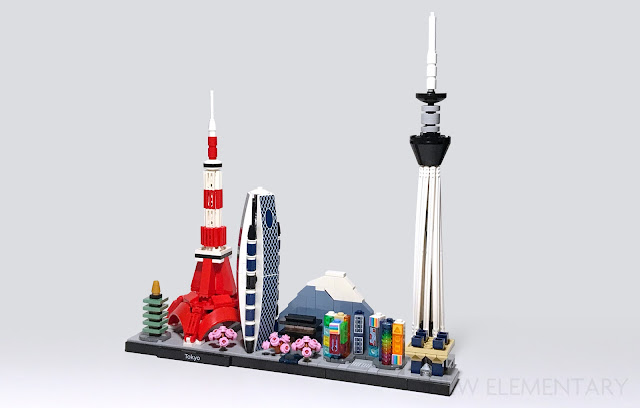
LEGO® Architecture goes small in Japan in the latest addition to the Skylines subtheme. 21051 Tokyo depicts a composite skyline of the capital city, featuring eight different landmarks. The 547-piece set will be available January 1st, 2020, retailing for US$59.99 / £59.99.
Recolours in 21051 Tokyo
Before launching into the building process, let’s examine the newly recoloured parts which appear in the set!
Appearing in Bright Red/ Red for the first time are the 1X2 ‘love handles’ plate with 2 shafts (6286215|18649).
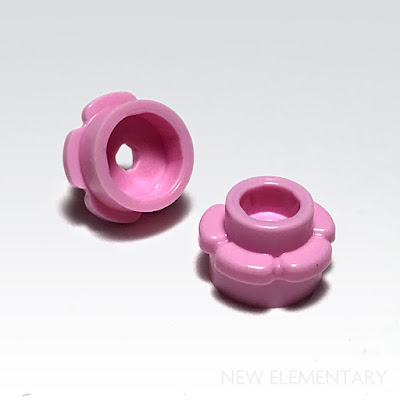
Debuting in Light Purple/ Bright Pink for the first time is the updated 1x1 flower (6212501 | 24866) element. While this may be the first appearance of this part, I think it is safe to assume that this will not be the last time we see this part/colour combination.
Printed Parts in 21051 Tokyo
In addition to recoloured parts, a number of new printed elements have been introduced to assist in creating Tokyo’s landmarks. Let’s take a look!

Two new printed White 2x8 bows (Design ID 42918) have been introduced specifically for the Mode Gakuen Cocoon Tower, after the introduction of the mould in 2019’s 10265 Ford Mustang (see our review here). One version (Element ID 6291465) features White crosshatched lines against a Earth Blue/ Dark Blue background, while the other (6286276) features the same pattern with the addition of a vertical Earth Blue oval.
One of the most exciting new elements in the set may actually be a new Medium Stone Grey/ Light Bluish Gray 1x1 tile decorated with four white stripes (6286223). While its most obvious use is as a microscale crosswalk, as it is used for here, I imagine this element will be well-received by a number of builders in different genres given its abstract decoration which lends itself to multiple uses.
Continuing a tradition around since the start of the Architecture series, a Black 1x8 tile with ”TOKYO” printing (6212501) is included for labeling the base of the model.
Rare Elements in 21051 Tokyo
While none are new, several rare elements show up in 21051 Tokyo after having only made a single other appearance.
After debuting in 20145 Trafalgar Square in August 2019, the White 1X1 tile with rainbow stripes (6253635|48272) makes a return in set 21051. What’s more, the set contains three of these tiles, which should make them easier to obtain in the future.
After a year-long hiatus, the Transparent Bright Orange/ Transparent Orange 1x1 tile with Bright Yellow/ Yellow rectangle and triangle cutout (6255958|44286) reappears here. The last appearance of this element was in 70829 Emmet and Lucy’s Escape Buggy at the start of 2019.
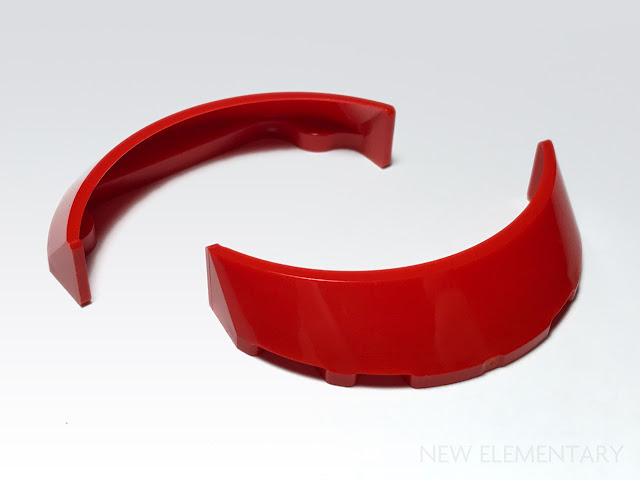
The 3X6X1 windscreen (6286218|62360) appears in Bright Red/ Red here for the first time since 75525 Baze Malbus, a Star Wars Buildable Figure from 2017.
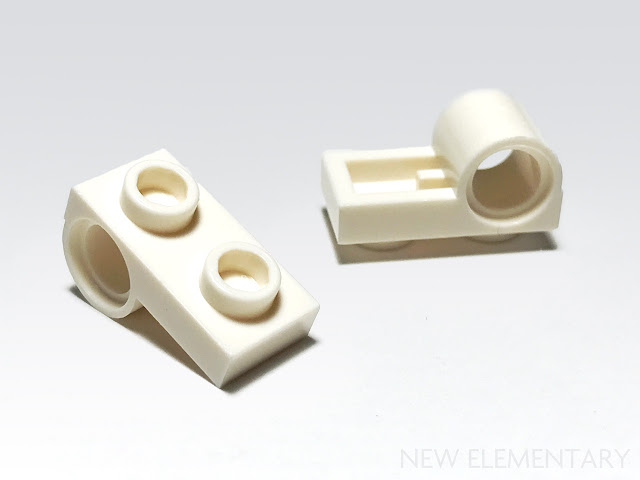
Last but not least, the set includes a White 1X2 plate with horizontal Technic hole on bottom (6232029|28809). This element has previously only appeared in 41168 Elsa’s Jewellery Box.
Building Process and Techniques

The kit is divided into two sets of bags. The first set of bags contains parts for constructing the base of the model and Tokyo Tower, while the latter contains the parts for building the Mode Gakuen Cocoon Tower, Chidorigafuchi Park, Shibuya Crossing, Tokyo Big Sight, and Tokyo Skytree.
Early in the building process, it becomes clear that the designer(s) have employed a variety of clever techniques to accurately capture the features of the original buildings.
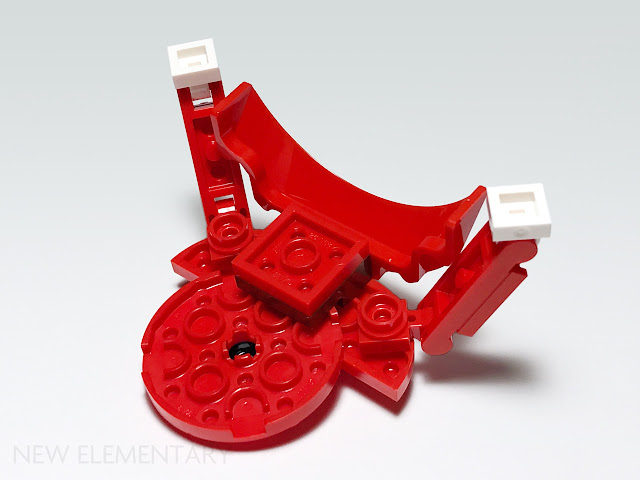
To create the distinctive arched legs of the Tokyo Tower, curved 2x6 windscreens are mounted vertically to a 2x2x2/3 brick with two vertical studs. To attach the support legs, two 1x1 plates with horizontal clips are attached to the bottom of a 2x6 rounded plate, whose corner gaps lock the clips at 45° angles.

The tapered lower body of the tower is also constructed in an unusual fashion, with four inverted 1x2x3 slopes attached upside-down to a core of SNOT bricks, in order to minimize the number of studs visible on the model.

The remainder of bag one is straightforward, leaving you with a sleek-looking base and Tokyo Tower.

Bag 2 begins with the construction of Chidorigafuchi Park, which is characterized by its flowering trees, moat, and a section of the Tokyo Imperial Palace.
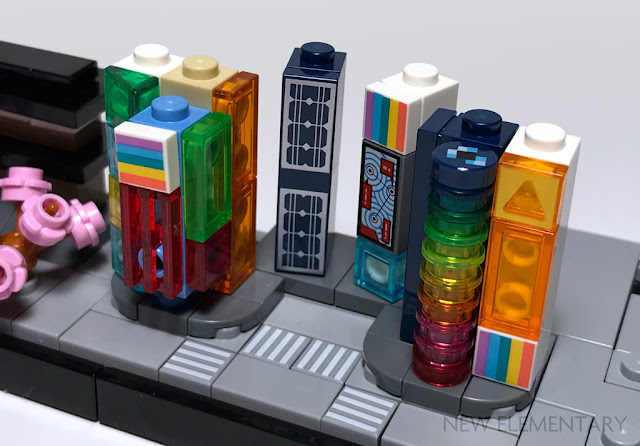
Next, Tokyo’s famous Shibuya Crossing is built. The buildings overlooking the crossing are assembled by applying tiles to 1x1x1 2/3 bricks with two studs on the side. The 1x1 tiles with four white stripes are used to create the crosswalks of the iconic scramble crossing.
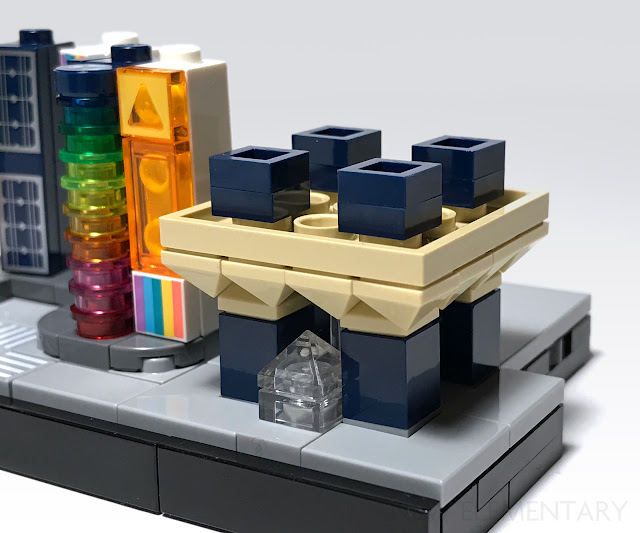
The Tokyo Big Sight building is the next landmark to be assembled. The building features four distinctive inverted pyramids which support the roof. To recreate this, the set designer has once again utilized a clever building technique.
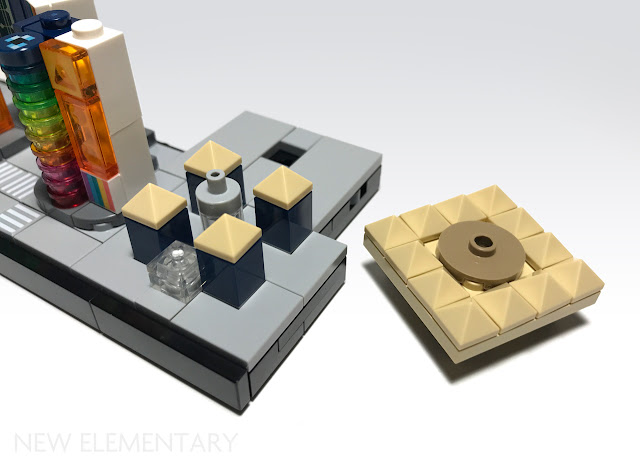
The core of the building features a 1x1 round brick with a 'nipple' brick on top, surrounded by four 1x1 bricks with 1x1x2/3 pyramid slopes. The roof, meanwhile, is constructed using a 4x4 plate with a 2x2 round plate with single stud in the center, surrounded by pyramid slopes. When these components are connected upside down (via the nipple brick), a 1/2 brick offset along both axes allows the pyramids on both surfaces to fit together and approximate a larger inverted pyramid.

Following this, the Mode Gakuen Cocoon Tower is assembled. The building is assembled as three identical sides, which are mounted to Technic Y-connectors along a Technic axle which is attached to the model base.
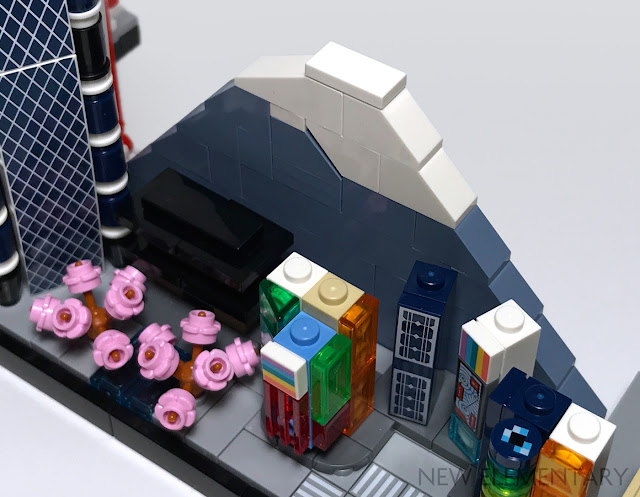
Along the back of the model, a miniature version of Japan’s iconic Mount Fuji is constructed from layered Sand Blue bricks and White slopes for the snow cap. Forced perspective is used to create the illusion that mountain rises over the city in the distance.
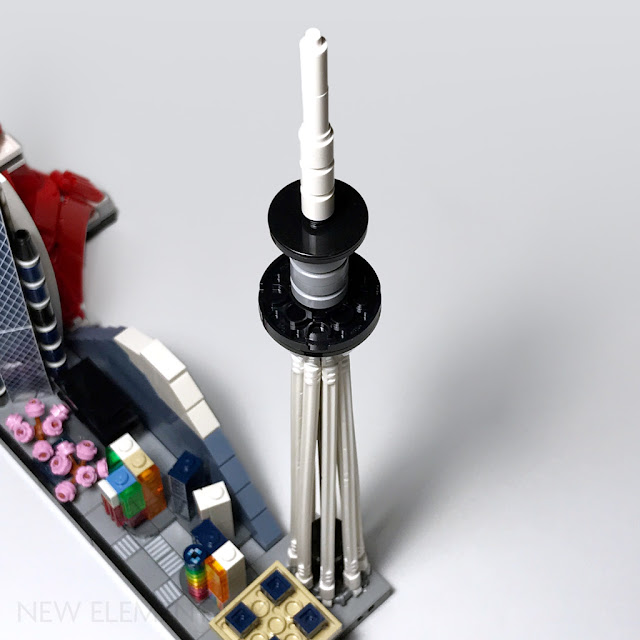
The last portion of the model to be assembled is the Tokyo Skytree. The building is constructed around a series of Technic axles which are later covered by flexible hoses representing building supports. Interestingly, rather than being attached on both ends, these hoses are attached only to the octagonal plate at the bottom of the tower. Towards the top, the ends of the hoses are fed into a 4x4x3 round cylinder with hole, which helps to keep the hoses bunched together.
Finished Model
The finished Tokyo model serves as a wonderful addition to the LEGO Architecture Skyline range, showcasing the sights associated with Japan’s largest city.
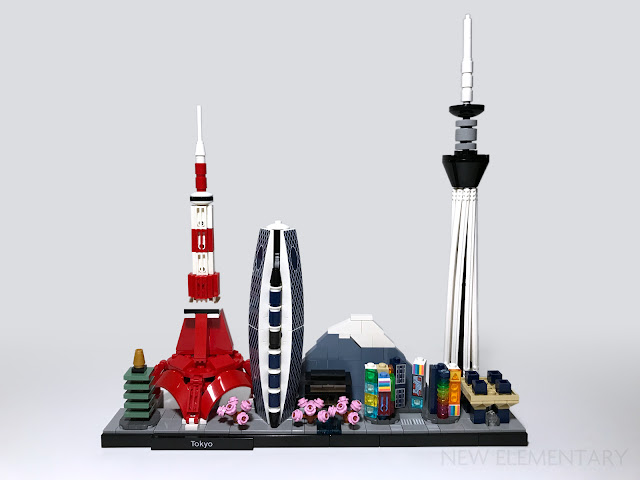
The model offers a number of useful new parts and an enjoyable construction process full of techniques and details to keep the interest of the builder. The addition of a brick-built Mount Fuji is particularly appreciated, offering a backdrop for the shorter sections of the model, and helping the finished model to stand out when compared to previous Skylines sets which have lacked natural landmarks.
My only hesitation in recommending the set is the retail price, which represents a steep price increase compared to similarly sized sets such as 2019’s 21043 San Francisco and 21043 Paris (read our review here).
Help New Elementary keep publishing articles like this. Become a Patron!
Thanks to our 'Vibrant Coral' patrons: Iain Adams, Ryan Welles, Chris Cook, London AFOLs, Gerald Lasser, Big B Bricks, Dave Schefcik, David and Breda Fennell, Huw Millington, Neil Crosby, Antonio Serra, Beyond the Brick, Sue Ann Barber & Trevor Clark, and Kevin Gascoigne. You're all awesome!
Search New Elementary
Products mentioned in this post were kindly supplied by the LEGO Group. All content represents the opinions of New Elementary authors and not the LEGO Group. All text and images are © New Elementary unless otherwise attributed.
World's No. 1 source for LEGO news, reviews, and fan creations.
It’s not often that a LEGO set transports me back home. But regular readers of The Brothers Brick know that I was born in Tokyo and lived in Japan until I was a teenager, so I was incredibly excited when LEGO announced 21050 Tokyo. I’ve enjoyed each of the previous LEGO Architecture skyline sets I’ve built, but how does this one stack up for someone who calls Tokyo their hometown?
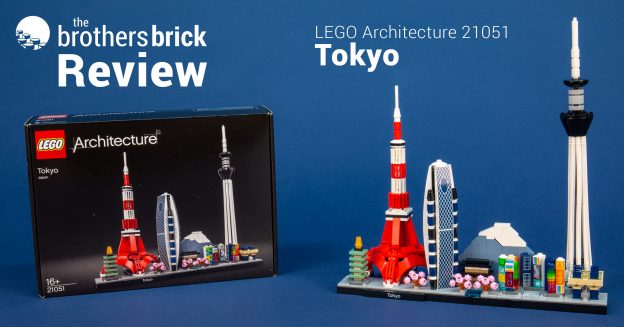
Tokyo was revealed as part of the LEGO Architecture skyline series for 2020, alongside 21052 Dubai. Tokyo is built from 547 pieces and will retail for $59.99 USD | $79.99 CAD | £59.99 GBP. Both sets will be available starting January 1st.
The packaging & instructions
Looking beyond LEGO’s core market of kids and even the kind of adult builders we feature here on The Brothers Brick, LEGO Architecture sets are often sold in tourist hot spots, museum gift shops, and other places where the average LEGO builder might not shop. Likely as a result, LEGO Architecture sets are sold in sturdy double-folded boxes with interior printing and other details indicating they’re designed to be used to store your set rather than parting it out into your “build-fodder” collection. The back of the box provides helpful callouts that tell you what landmarks are featured in the LEGO set.


It’s notable here that Tokyo Skytree is mislabeled “Tokyo Skyline” on the back of the box — an unusual copyediting miss, and something likely to be corrected quickly in subsequent printings of the box. (Our packaging is the European packaging sent to us from LEGO HQ in Billund, Denmark.)
The instruction booklet features introductory pages with quotes about Tokyo and information about each of the locations.
LEGO Architecture sets have always had black-themed packaging and instructions, which does present some challenges during the building process. While some darker colors include white highlighting around them, other colors like dark blue may not, making it hard to distinguish parts and colors in normal living room lighting conditions (as opposed to under studio or office lights where these booklets are designed). The same is true for transparent pieces — I’m still not confident that the tall stack of 1×1 round plates in a rainbow of transparent colors that I ended up building was correct.
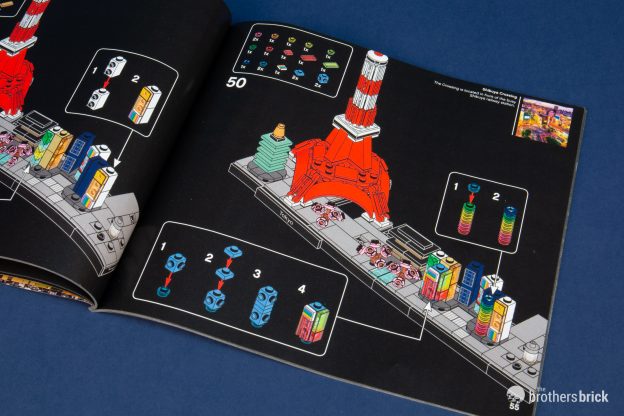
The build & individual buildings
After creating the base, the build process follows a left-to-right order for each of the structures on the base.
When complete, 21051 Tokyo skyline features the following named buildings and locations, from left to right:
- Tokyo Tower
- Mode Gakuen Cocoon Tower
- Chidorigafuchi Park
- Shibuya Crossing
- Tokyo Skytree
- Tokyo Big Sight
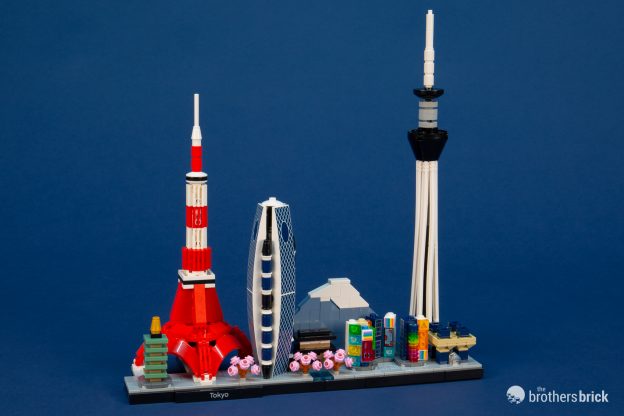
In addition to the locations named on the box, the skyline features a five-level pagoda, a mountain that is obviously intended to be Mount Fuji, and a temple/shrine gate behind the blooming cherry trees of Chidorigafuchi (something I’ll come back to later). Follow me home as we take a closer look at each of these locations in turn…
Tokyo Tower was built in 1958 and stands 333 meters tall, painted for visibility in alternating red and white. Tokyo is the largest city in the world, and there are places in the city I never visited, either while living in Japan for 15 years or when I visited most recently this past June for Japan Brickfest 2019. Nevertheless, Tokyo Tower is indelibly and iconically linked to the city in my mind — always there, much like the Space Needle here in Seattle (which many locals have similarly never visited).
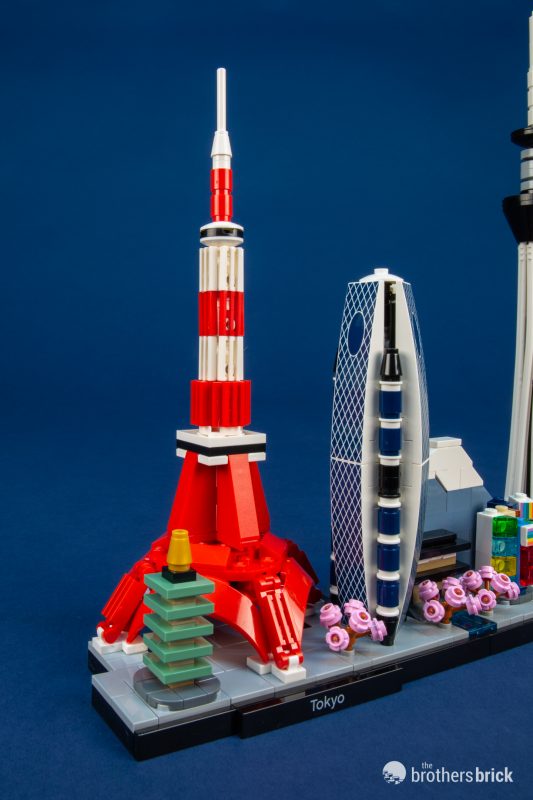
The LEGO version incorporates red Speed Racer windscreens as the arches in the tower’s base, with inverted 1x2x3 slopes turned upside down leading up to the first observation deck. The whole structure is connected through its core via simple bars rather than more-complex connections or Technic axles.
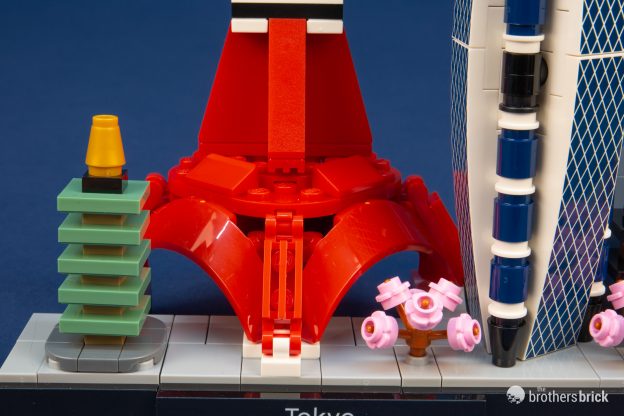
Standing next to Tokyo Tower in the LEGO set (but about 10 km apart in the real city) is the Mode Gakuen Cocoon Tower, which houses several educational institutions. Designed by the architectural firm Tange Associates and completed in 2008, the tower has won architectural awards and is located in the Shinjuku central business district.
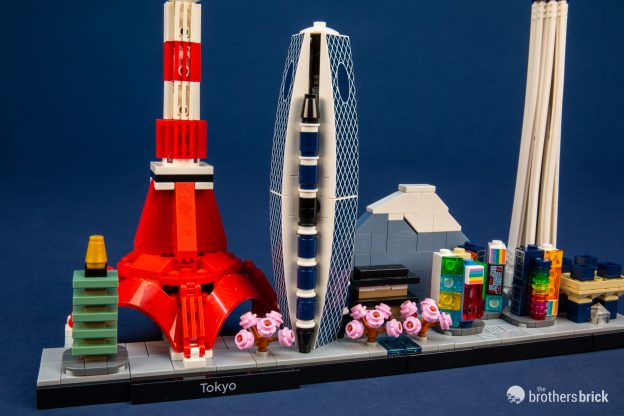
The tower’s distinctive latticework exterior is recreated in LEGO through printing on curved slopes, attached with Technic 3-branch cross-axles. I’m not entirely convinced, though, that the stack of 1×1 round bricks works to bring together the three sides in a smooth curve.
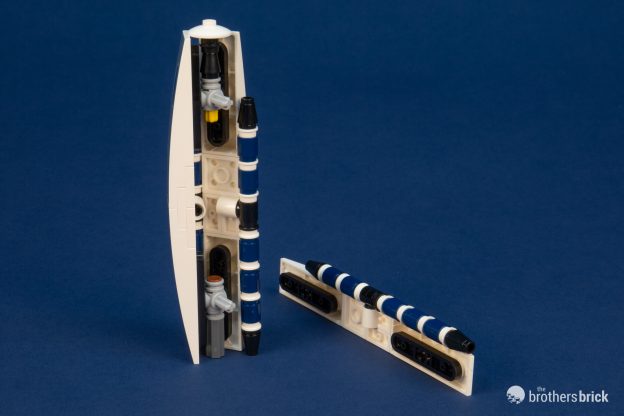
Next, Chidorigafuchi Park is a popular spot for viewing cherry blossoms in the spring. The park is on the moat of the Imperial Palace, which is captured as a pair of 1×2 trans-blue tiles. Behind the cherry blossoms and the moat is a gatehouse.
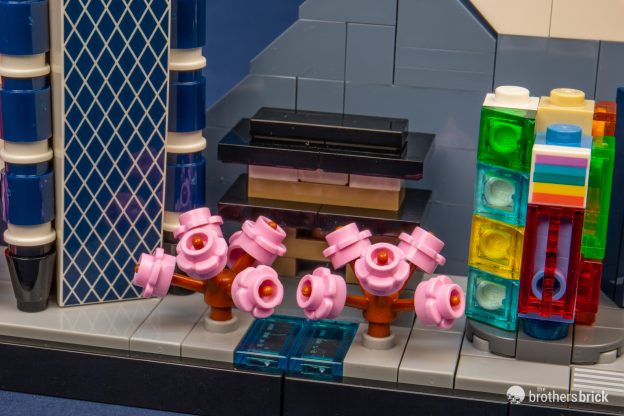
The problem is that this tiny, two-story gatehouse is in an architectural style used for Buddhist temples like Sensō-ji in Asakusa and Shinto shrines like Meiji Jingu in Shibuya. Castle gates follow a very different architectural style, and the Imperial Palace is built like a castle, in standard black and white rather than natural wood or painted red, like the famous “Thunder Gate” (Kaminari-mon) I took a selfie at a few months ago. Juxtaposition is expected in LEGO Architecture skyline sets, but placing this gatehouse in the set’s Chidorigafuchi Park without naming it as representing something like a Meiji Shrine gate seems like a huge missed opportunity. Personally, I think the pop of red for a Buddhist temple gate, with a printed minifigure head for the huge paper lantern, would have been an amazing detail much more representative of the city than a generic brown gate in the background of a location that has no such gate.
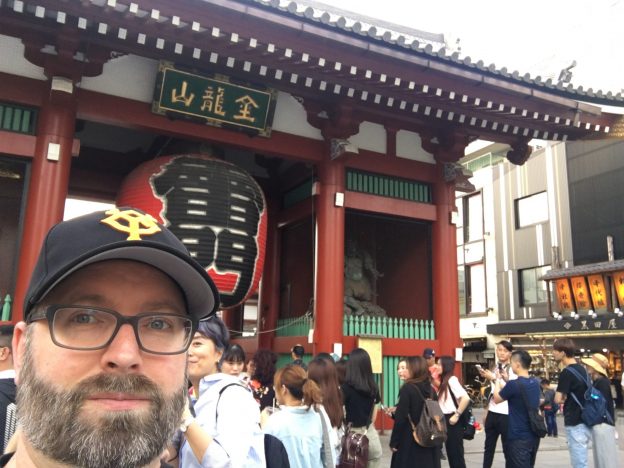
Shibuya Crossing just outside Shibuya train station is sometimes called the “crazy crossing” and features prominently in movies like Lost in Translation. It’s an intersection in which thousands of pedestrians cross at once when the traffic lights stop in every direction. Like Times Square in New York City, the buildings around the crossing are covered in illuminated signage right up to the top, and it’s been a favorite spot for “iconic” Tokyo tourist photos for 40 or 50 years.
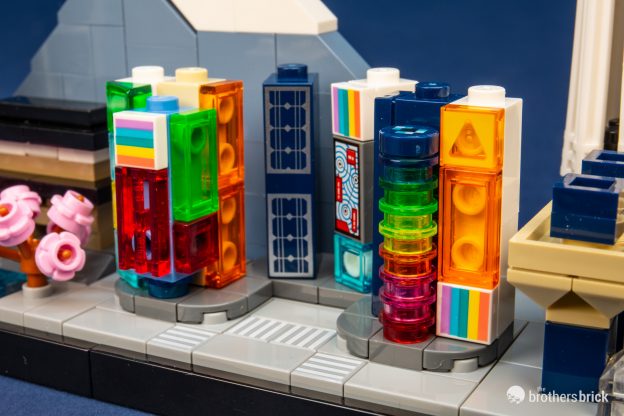
Shibuya looks amazing at night, and one of my favorite photos from my trip in June is this photo of Shibuya Crossing at dusk.
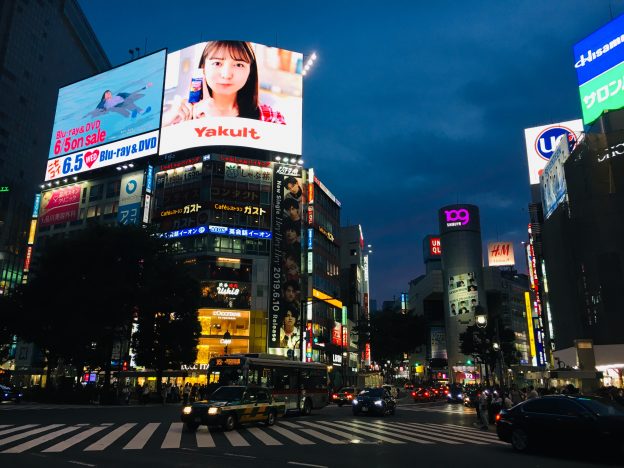
Even though the scale is too tiny to show scurrying pedestrians, and LEGO hasn’t sought several dozens of new licensing deals to show Yakult, Salonpas, or UC Coffee signage, I love how the designers used a variety of printed and transparent pieces to recreate the crazy look of this famous location, complete with printed 1×1 crosswalk tiles (which are new).
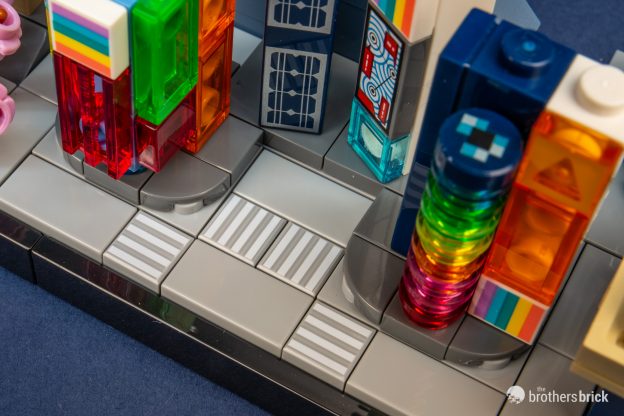
Behind Chidorigafuchi Park and Shibuya Crossing looms Mount Fuji (or Fuji-san in Japanese — never “Fuji-yama”), an active strato-volcano (which last erupted in 1707) about a hundred kilometers away from downtown Tokyo, but visible on the horizon on any clear day. During my trip in rainy June, while also traveling between Osaka and Tokyo at night, I’m disappointed that I never saw Mt. Fuji once. Nevertheless, it’s such an integral part of the Kanto region landscape (and Japanese iconography more generally) that anyone who’s spent more than a few months in Japan should be able to depict Mt. Fuji from memory.
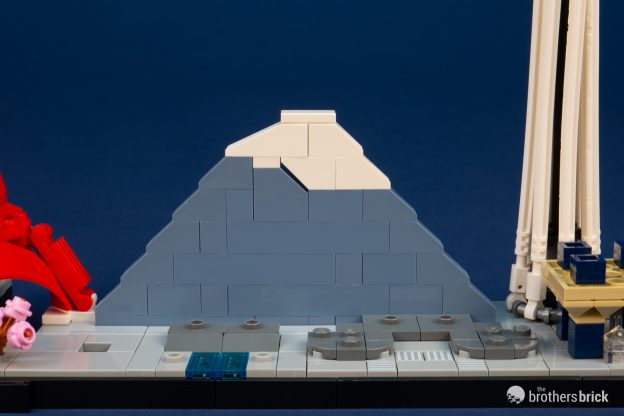
There are two key elements to an accurate symbolic representation of Japan’s highest peak: The cone tapers more steeply near the peak, and the snowcap sits atop the peak with a clean, straight line between the peak itself and the rest of the mountain. Not so with this Mt. Fuji, which has a weird slope in the wrong direction on the left and an uneven snowcap. Mt. Fuji is such a basic element of Japanese iconography and the landscape beyond Tokyo that there is no excuse for getting this wrong. Oddly for me as a Tokyo-born Seattleite, this bad Mt. Fuji looks to me like a fairly good Mt. Rainier — about the same distance from the city, and with a much more rounded peak than Fuji.
I had the privilege of seeing an original print of Hokusai’s “The Great Wave off Kanagawa” at the Tokyo National Museum during my summer trip, and this is an accurate artistic rendition of Tokyo. There’s a simplicity to Mt. Fuji’s shape that inspires beauty in great works of art. By adding unnecessary complexity through the asymmetrical summit and snowcap, the LEGO Architecture designers have delivered a Fuji that has been reduced in stature. More is not necessarily better.
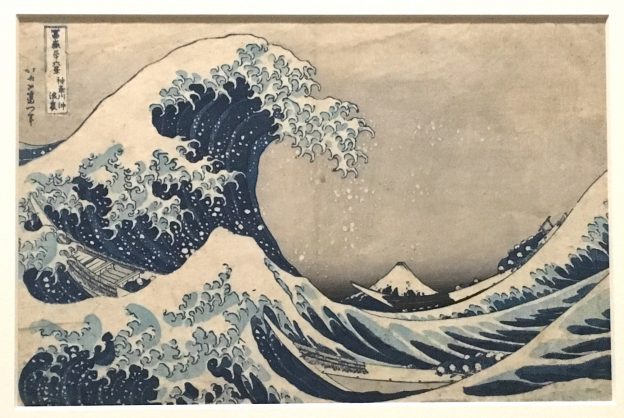
The tallest free-standing structure in the world is Tokyo Skytree at 634 meters. Completed as a broadcasting tower to replace Tokyo Tower (with the shift to digital broadcasting) in 2012, it’s also the second-tallest building in the world, topped only by the Burj Khalifa in Dubai. As a result, Tokyo Skytree dominates Tokyo’s skyline from just about any direction.
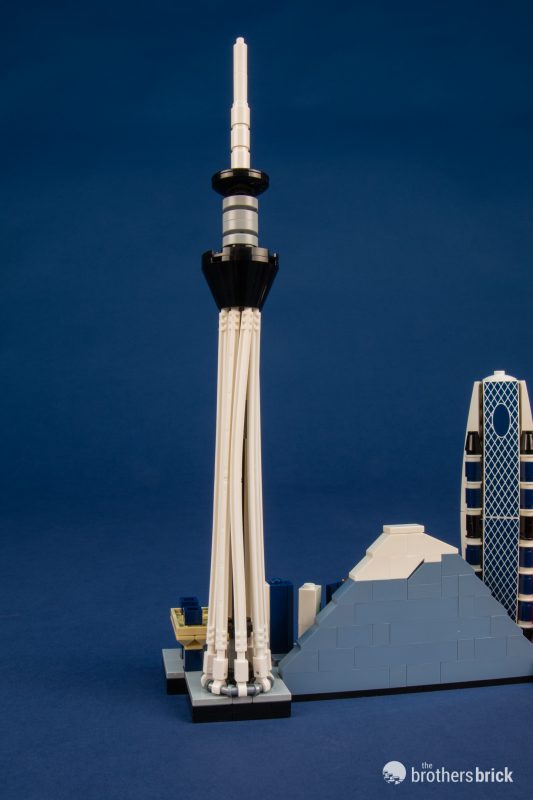
The tower looks great in the set’s promotional photos and on the box, but the struts of the LEGO version are built from rubber Technic axles, which are not straight and do not curve correctly when actually used in the set, as is immediately obvious in the photo above. There is no straightforward way to correct this problem, since the tops of the rubber axles are not actually connected to anything — they’re simply bundled under the inverted cone piece with an open center.
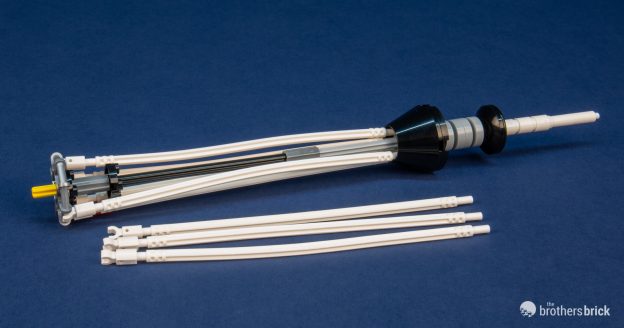
The final location in the LEGO Architecture Tokyo skyline is Tokyo Big Sight, an exhibition and convention center located on the Tokyo Bay waterfront. The conference tower with its inverted pyramids was designed by the architectural firm AXS Satow and completed in 1996. The LEGO version uses 16 1×1 pyramids in an attempt to reproduce the shape of the structure, with the top inverted and connected in the center via a pin. Unfortunately, the pyramid-to-pyramid inverted connection doesn’t create an actual pyramid shape, and the exposed anti-studs on the top of the roof are distractingly unfinished. Overall, the build doesn’t really work, and given that this is not a famous or highly visible landmark like Tokyo Tower or Shibuya Crossing, its inclusion is a bit baffling.
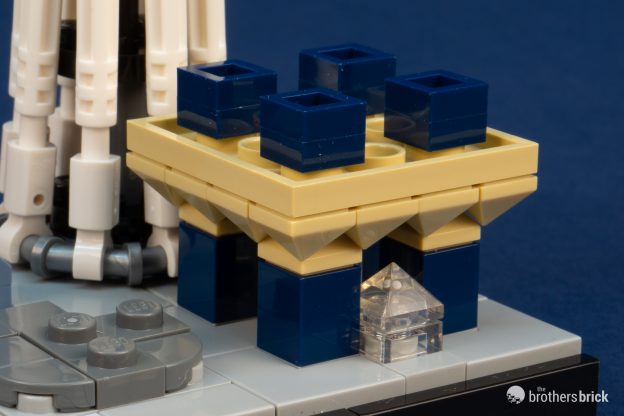
The printed parts in this set are nothing if not generous. In addition to the necessary “Tokyo” tile and all the curved slopes for the Mode Gakuen Cocoon Tower, there are lots of great 1×1 tiles, including sidewalks and rainbows.
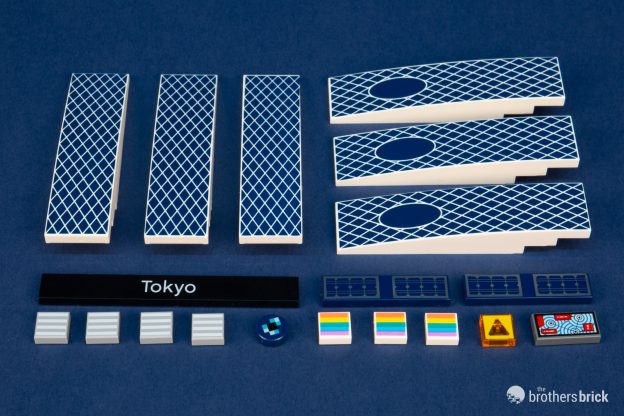
The inclusion of printed 1×1 tiles means that you get a ton of bonus tiles!
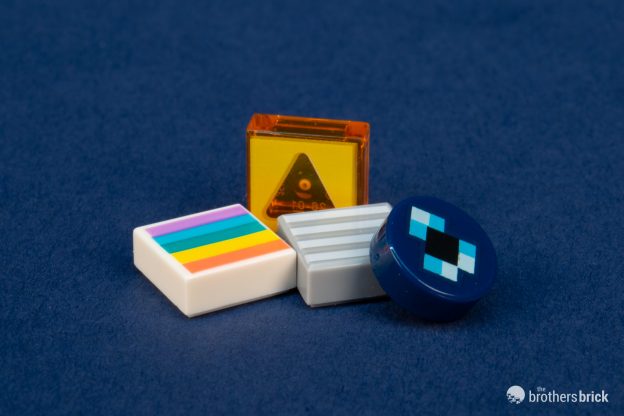
Conclusions & recommendation
My response to LEGO’s attempt to reflect my hometown in bricks is inherently and deeply personal, and therefore very subjective. Tokyo means something very different to me than the city does to someone visiting from abroad, someone creating a LEGO set from a distance, or even someone who’s never left. Despite the simultaneous closeness and distance I feel toward the city of my birth, my recent trip only confirmed Tokyo as my favorite city in the world. As a result, I’m incredibly passionate about seeing Tokyo depicted in LEGO as it “should” be.
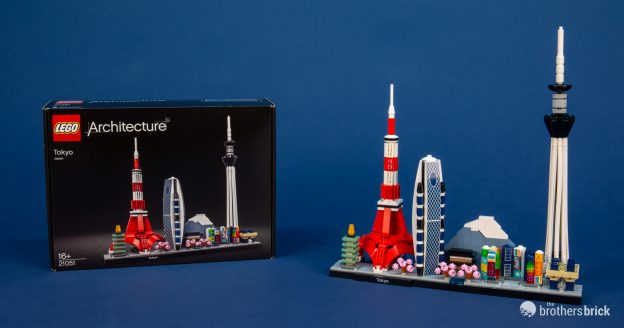
This perspective originated when I built my own microscale Tokyo back in 2011, many years before LEGO got into the microscale city skyline business. My tiny Tokyo (built to the modular Micropolis standard) featured Shibuya with not just the iconic corner buildings with their advertising but also a train station with vintage orange and lime rolling stock, as well as a bullet train speeding away from the city. I’ve included the National Diet building (essentially, the country’s capital building), as well as a Shinto shrine with torii gate and blooming azaleas. But my Tokyo isn’t all landmarks and pretty landscaping. My Tokyo also has the horrible mid-century apartment blocks that bulk up any urban skyline, cranes at the seaport, and boring old warehouses.

I’m not suggesting that a LEGO Architecture version of Tokyo should include apartment blocks and warehouses, but the selection does feel like the design team didn’t spend enough time researching Tokyo — even by Googling “best places to visit in Tokyo” or “most important architecture in Tokyo.” This is reinforced by the completely generic pagoda and temple gatehouse included haphazardly in the set. There is only one well-known pagoda in Tokyo, at Sensō-ji in Asakusa, and yet the five-story pagoda at the base of Tokyo Tower is not named at all in the set.
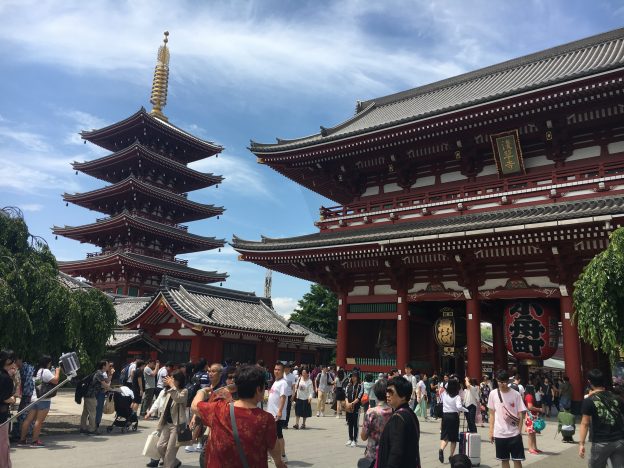
Tokyo Tower, cherry blossoms in Chidorigafuchi Park, Shibuya Crossing — all of these are core to what makes Tokyo one of the greatest cities in the world. But it is also a city infused with sadness. Tokyo was nearly burnt to the ground twice in the first half of the 20th century — first during firestorms caused by the Great Kanto Earthquake of 1923, then again by American firebombing toward the end of World War II (killing at least 100,000 civilians). Very little survives of historical Tokyo. This makes every connection to the past precious, even when the pagoda at Sensō-ji was rebuilt in the 1960’s and Meiji Shrine was reconstructed in the 1950’s. At the same time, the structures in LEGO Architecture skyline sets have always been named landmarks. So to leave a pagoda and temple/shrine gate totally unnamed feels like they’ve been added to the cityscape in the service of an Orientalist aesthetic rather than a genuine commitment to real Japanese places (and the real people who inhabit them).
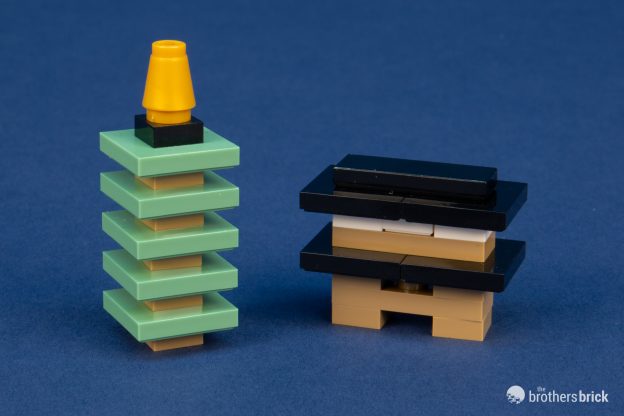
To call this set disappointing for a native Tokyoite would be an understatement. I can forgive strange choices like the Tokyo Big Sight conference tower, and I truly love this LEGO rendition of Tokyo Tower and Shibuya Crossing. But a Mt. Fuji that looks like Mt. Rainier, Tokyo Skytree with squishy legs, and historic architecture that remains unnamed (against the conventions of other LEGO Architecture sets) are all unforgivable. What’s most disappointing is how close this set is to great, if only the designers had bothered to do a modicum of research about the history and culture that resulted in the architecture depicted in the set.
LEGO Architecture 21051 Tokyo skyline includes 547 pieces and will be available starting January 1st, 2020 from the LEGO Shop ($59.99 USD | $79.99 CAD | £59.99 GBP) and elsewhere.
Don’t miss our reviews of previous LEGO Architecture skyline sets:
The LEGO Group provided The Brothers Brick with an early copy of this set for review. Providing TBB with products for review guarantees neither coverage nor positive reviews.
Читайте также:

